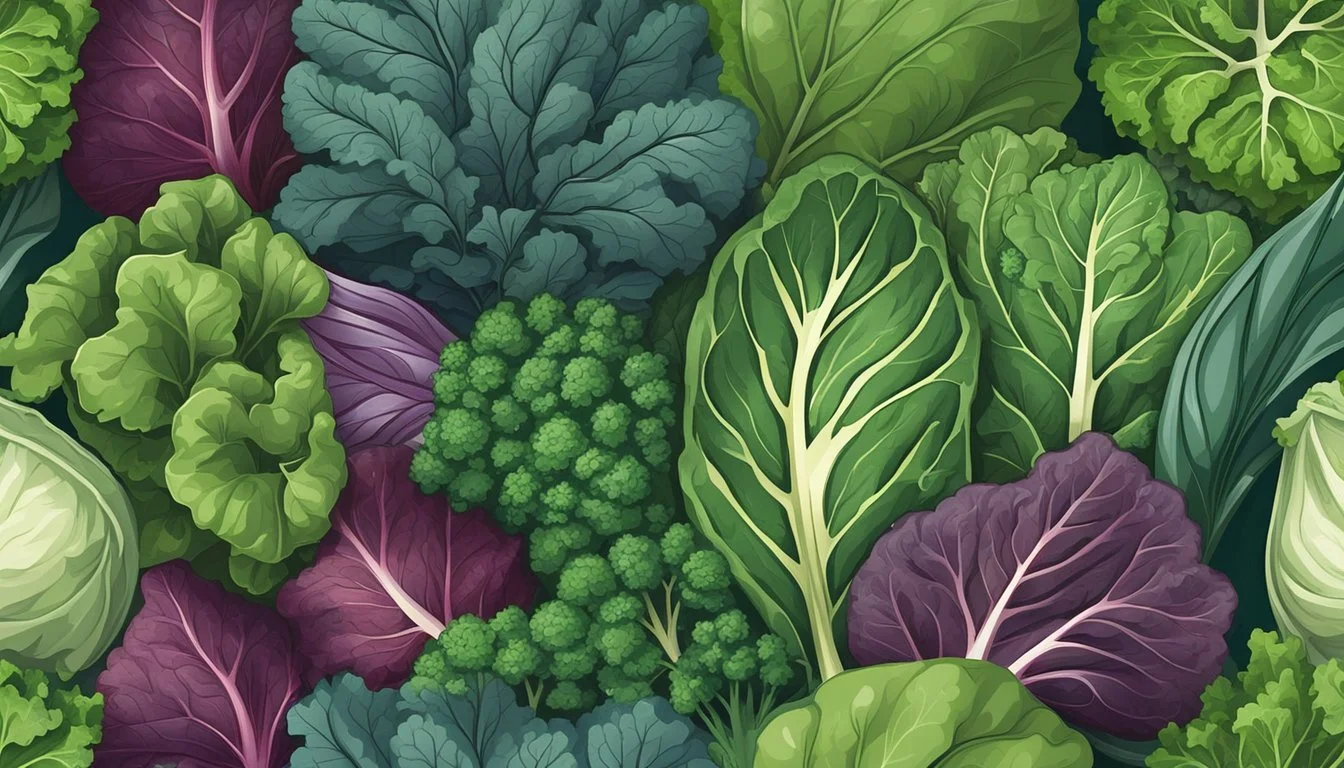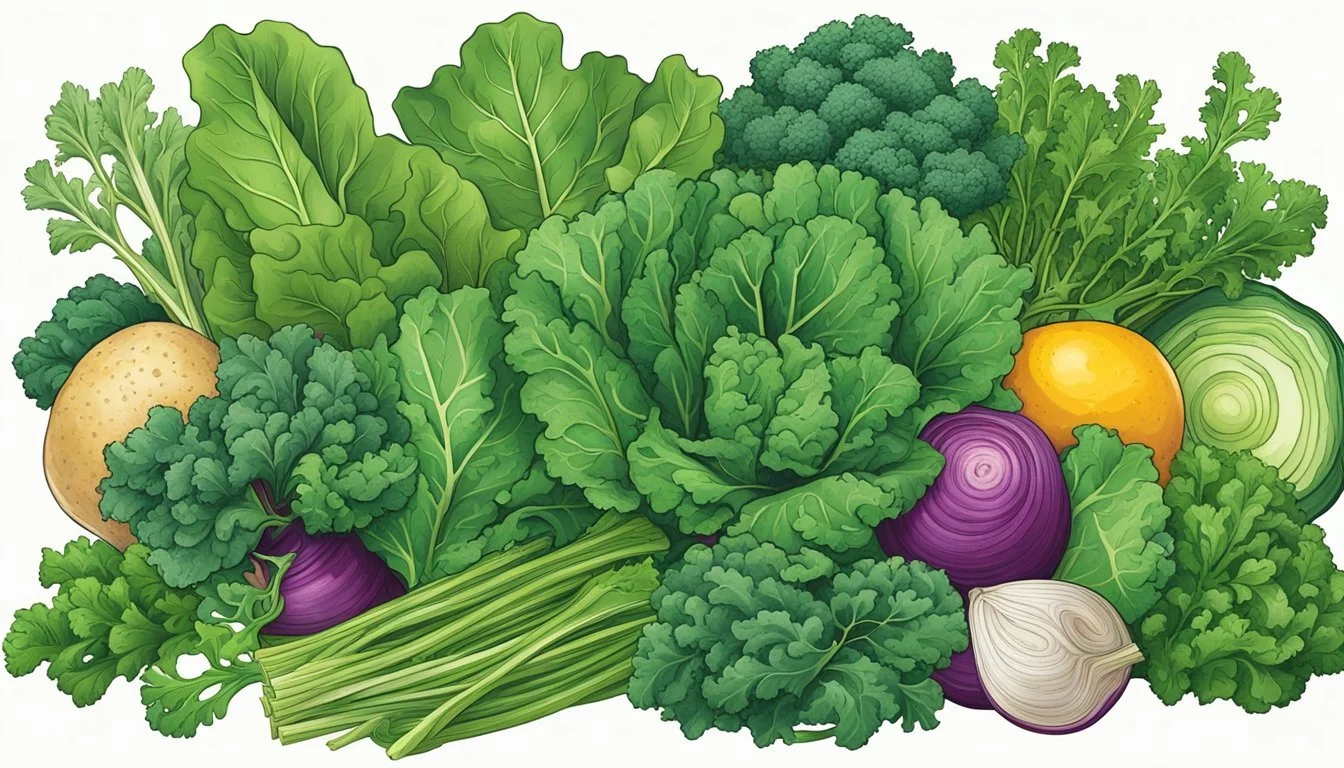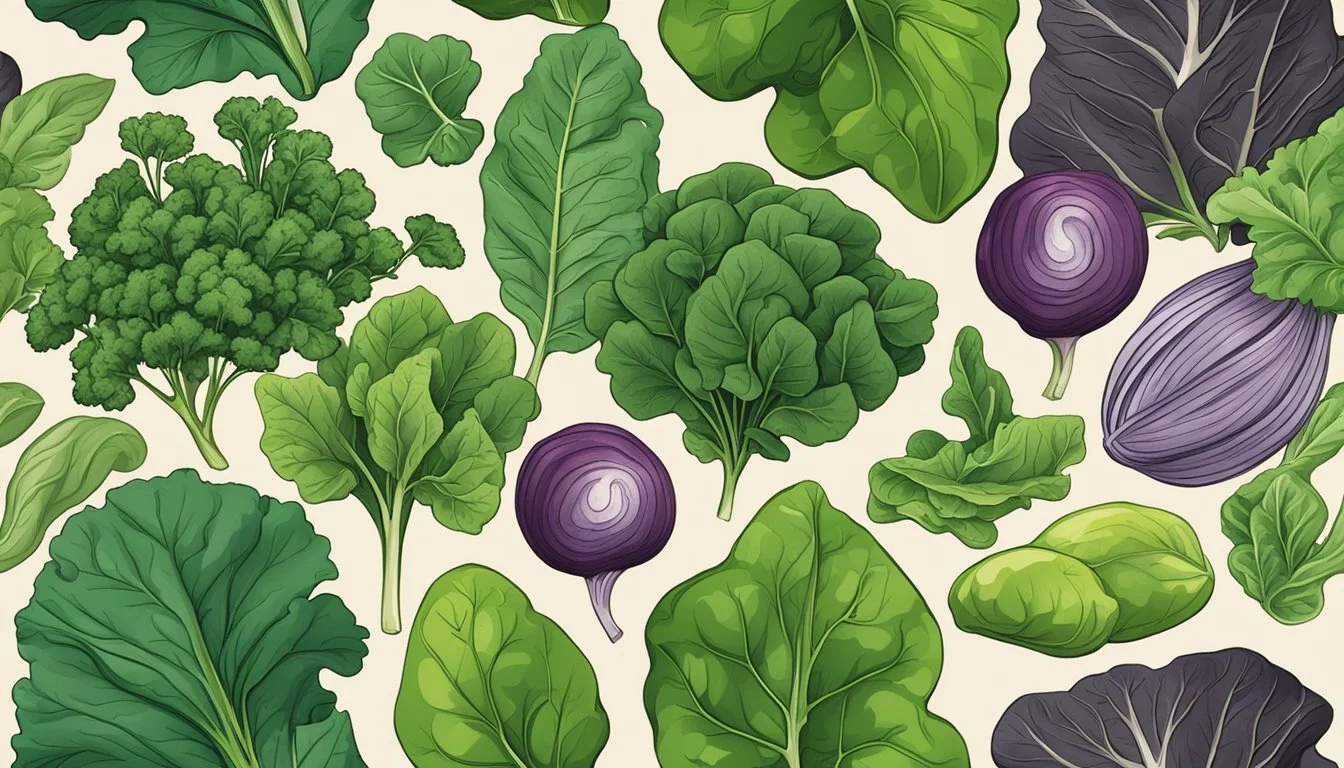Kale Substitutes
Best Alternatives for Nutrition and Taste
When it comes to finding a suitable alternative to kale, there are numerous vegetables that can seamlessly step in without compromising on nutrition or flavor. Whether you're out of kale or looking to diversify your vegetable intake, exploring these substitutes can add a new dimension to your meals. Collard greens, for instance, offer more calcium, iron, fiber, and protein than kale, making them a robust choice for maintaining a nutrient-rich diet.
Romaine lettuce can be another viable option, especially in salads and sandwiches, though its milder taste may require extra seasoning. On the other hand, arugula adds a zippy flavor that can enhance your salads and wraps without the need for extensive preparation. Swiss chard stands out for its earthy taste, making it ideal for hot dishes like soups and sautés.
These alternatives not only deliver on nutritional benefits but also bring diverse flavors and textures to your dishes. Mustard greens, with their spicy kick, and baby spinach, with its tender leaves, can refresh your palate and keep your meals exciting. Whether you're aiming to match the robust taste of kale or try something new, these options ensure you never compromise on health or flavor.
Understanding Kale
Kale is a nutrient-dense leafy green vegetable renowned for its health benefits and versatility in the kitchen. It can be eaten raw or cooked, and its robust nutritional profile makes it a favorite among health-conscious individuals.
Nutritional Profile
Kale stands out for its impressive array of vitamins and minerals. It is particularly rich in vitamin K, which supports blood clotting and bone health. A single cup of raw kale provides nearly 700% of the daily recommended intake of vitamin K.
Additionally, kale is a good source of vitamin A and vitamin C. Vitamin A is essential for vision and immune function, while vitamin C is an antioxidant that protects cells and supports skin health. It also contains calcium for bone health, iron for blood production, and fiber which aids in digestion. Minerals such as magnesium and manganese are present, contributing to various enzymatic and physiological functions in the body.
Culinary Uses
Kale's versatility in culinary applications is noteworthy. When used raw, kale adds a crunchy texture to salads and smoothies. It pairs well with fruits, nuts, and cheese in salads, and its robust leaves do not wilt quickly, making it an excellent choice for make-ahead meals. For smoothies, blending kale with other fruits and vegetables can create a nutrient-packed drink.
In cooked dishes, kale can be sautéed, steamed, or added to soups, stews, and stir-fries. Sautéing kale with garlic and olive oil brings out a savory flavor that complements many recipes. Adding kale to soups and stews enhances the nutritional content and provides a hearty texture. It can also be baked into chips for a healthy snack alternative.
Kale’s versatility extends beyond salads and cooked dishes; it can even be used as a garnish or in pesto, making it a valuable green to keep on hand in any kitchen.
Health Benefits of Kale
Kale is a nutrient-dense leafy green that offers numerous health benefits, from reducing the risk of chronic diseases to supporting weight management and bone health.
Heart Disease and Cancer Prevention
Kale is rich in antioxidants such as quercetin and kaempferol. These compounds help neutralize free radicals and reduce inflammation, lowering the risk of heart disease and certain cancers.
The high levels of vitamin C and beta-carotene in kale contribute to its protective effects. Fiber, abundant in kale, supports heart health by helping to reduce cholesterol levels. Kale also contains glucosinolates, which are believed to help prevent cancer by aiding in the detoxification process and inhibiting cancer cell growth.
Weight Management
Kale is low in calories but high in essential nutrients, making it an excellent choice for weight management. One cup of raw kale has only 33 calories but provides a substantial amount of vitamins A, C, and K.
The high fiber content in kale promotes a feeling of fullness, which can help reduce overall calorie intake. Moreover, the low energy density of kale enables people to consume larger portions without dramatically increasing their calorie intake.
Bone Health
Calcium is critical for maintaining bone health, and kale is an excellent plant-based source. One cup of cooked kale delivers about 10% of the recommended daily intake of calcium.
In addition to calcium, kale is rich in vitamin K, which plays a pivotal role in bone metabolism and helps improve bone density. Regular consumption of kale thus supports the development and maintenance of healthy bones, making it a valuable addition to the diet, especially for those at risk of osteoporosis.
Top Kale Substitutes
Kale is versatile, showing up in everything from fresh salads to hearty soups. Various substitutes can replicate its texture, nutritional benefits, or unique flavor profile, depending on how it's used.
For Raw Applications
Romaine Lettuce: With a mild taste and crunchy texture, romaine lettuce works well in fresh salads and wraps. It lacks the strong flavor of kale but provides a pleasant, crisp bite.
Arugula: Known for its peppery flavor, arugula can replace kale in salads, adding a spicy kick. Its tender leaves are best used fresh and not in cooked dishes.
Baby Spinach: Baby spinach has a tender texture and mild flavor that fits well in raw dishes. It's rich in nutrients like iron and vitamin C, making it a healthy alternative.
Watercress: This green offers a peppery taste like kale but is more delicate. It pairs well with lighter dressings.
For Cooking
Collard Greens: Collard greens have a hearty texture and slight bitterness, similar to kale. They hold up well in soups, stews, and stir-fries, offering substantial nutritional benefits.
Cabbage: Various types of cabbage, like green, savoy, and napa, are excellent for cooking. They can be shredded and used in soups, sautés, or stir-fries, providing a similar crunch to kale.
Mustard Greens: With a robust texture, mustard greens can be sautéed or added to soups. They carry a slight heat and mustard flavor.
Swiss Chard: Swiss chard stands up well to cooking and adds an earthy taste. Its stalks bring a slightly crunchy texture that works in sautéed dishes.
Unique Flavor Profiles
Bok Choy: This vegetable offers mild, crunchy stalks and tender leaves, making it a versatile substitute. It's great in soups and stir-fries, providing a different but enjoyable texture.
Chinese Broccoli: Known for its slightly bitter taste and firm texture, Chinese broccoli is an interesting alternative for many cooked dishes.
Beet Greens: Including both greens and stems, beet greens offer a slightly sweet, earthy flavor. They're nutritious and can be used in various cooked dishes.
Iceberg Lettuce: This lettuce is mostly water and has a crunchy texture but lacks the strong flavor of kale. It's best for adding texture in fresh salads rather than cooking.
Utilizing these substitutes will not only diversify meals but also provide various textures and flavors, enriching culinary experiences.
Substitutes in Specific Dishes
For those looking to replace kale in various dishes, there are several alternatives that work well. Depending on the dish, you can choose from a variety of greens and vegetables that match kale’s texture and nutritional profile.
Salads and Sandwiches
In salads and sandwiches, spinach is an excellent substitute owing to its tender texture and mild flavor. Arugula offers a peppery kick that can enhance the taste of your dish. Romaine lettuce provides a crisp bite and is particularly good in sandwiches. Swiss chard brings a slight bitterness and vibrant colors, adding visual appeal to salads. Collard greens can also be used, though they might need to be finely chopped due to their tougher texture.
Smoothies and Juices
When replacing kale in smoothies and juices, spinach stands out due to its high iron content and smooth blending capability. Baby spinach is particularly fitting as it blends seamlessly without leaving a gritty texture. Chard can also be a good option, providing a slightly earthy taste. Microgreens add a burst of nutrients and subtle flavors, making them an excellent addition to any smoothie. Romaine lettuce can be used for a milder taste and a similar nutritional punch.
Hot Dishes and Soups
In hot dishes and soups, collard greens are a top choice due to their similar texture and ability to hold up well under heat. Mustard greens add a spicy note that can elevate stews and stir-fries. Bok choy offers a slight crunch and works well in stir-fries and soups. Cabbage is a versatile option for soups and stews, providing both flavor and texture. Broccoli rabe can also be a flavorful substitute in pasta dishes or as a side in baked recipes. For those looking for a mild option, spinach works well, though it may need to be added later in the cooking process to prevent it from becoming too wilted.
Preservation and Storage
Proper preservation and storage techniques can significantly extend the shelf life of kale substitutes, reducing food waste and ensuring that you have fresh ingredients whenever you need them.
Storing Fresh Substitutes
To store fresh kale substitutes like Brussels sprouts, spinach, or chard, ensure they are kept in a cool, moist environment. Line a storage bag with paper towels to absorb excess moisture.
Place the greens inside and remove as much air as possible before sealing. Store the bag in the crisper drawer of your fridge, with stems facing the back for optimal freshness.
Spinach can be stored similarly by placing it in a zip-top bag with paper towels and refrigerating. Always check for moisture and replace the paper towels if they become too damp, ensuring the greens stay dry and last up to a week.
Extending Shelf Life
For long-term storage, consider blanching sturdy substitutes such as collard greens or Swiss chard. Boil water and submerge the greens for about two to three minutes, then immediately transfer them to an ice bath to stop the cooking process.
Once cooled, thoroughly dry the blanched greens using a salad spinner or paper towels. Lay them flat on a baking sheet and freeze. Once frozen, transfer to an airtight container or plastic bag for up to eight months.
Kale chips are another excellent way to extend shelf life. Toss kale leaves with a bit of olive oil, spread on a baking sheet, and bake until crispy. Store the chips in a sealed container at room temperature for a crunchy, lasting snack.
Choosing the Right Substitute
Selecting an appropriate substitute for kale involves examining factors like taste and texture, nutritional content, and availability. These considerations will help you choose the best alternative for your specific dish.
Taste and Texture Considerations
When replacing kale, consider the flavor profile and texture of the substitute. Collard greens have a hearty texture and slightly bitter taste, making them suitable for soups and stews.
Romaine lettuce offers a milder flavor and crunchy texture, ideal for salads and sandwiches. For a peppery flavor, arugula or mustard greens can add zest to your dish. Savoy cabbage provides a similar nutritional value and its mild flavor fits well in many recipes.
Nutritional Equivalence
To maintain the nutritional benefits of kale, choose substitutes with similar nutrients. Collard greens are rich in vitamin C, vitamin A, and folate. Mustard greens also offer a wealth of vitamins and have the added bonus of a slightly spicy flavor.
Savoy cabbage and green cabbage provide comparable vitamin content and can be used across a variety of dishes. Baby spinach is another excellent choice, bringing substantial amounts of iron and calcium to your meal.
Availability and Seasonality
Depending on your location and the time of year, certain substitutes may be more accessible. Romaine lettuce and iceberg lettuce are common and found in most grocery stores year-round.
Collard greens and mustard greens might be more seasonal, particularly in regions where they are locally grown. For off-season options, consider frozen alternatives like spinach, which retains much of its nutritional value after being frozen. Cabbage varieties are generally available all year and are versatile in many preparations.
Cultivating Your Own Substitutes
Growing your own kale substitutes at home can be both rewarding and beneficial. Whether you have a spacious garden or a small apartment balcony, there are ways to cultivate various leafy greens.
Growing Greens at Home
Growing leafy greens at home is straightforward and can include options like spinach, Swiss chard, and mustard greens. Spinach grows quickly and is rich in nutrients. Plant it in well-drained soil with plenty of organic matter and keep the soil consistently moist.
Swiss chard is another great option, offering vibrant colors and versatility. It prefers cooler temperatures and partial shade, making it suitable for different climates. Fertilize it with a balanced fertilizer to promote healthy growth.
Mustard greens provide a spicy kick and are part of the cabbage family. They thrive in full sun and well-drained soil. Plant them in rows or use a garden bed for optimal growth. Succession planting will ensure a continuous harvest.
Container Gardening for Apartments
For those living in apartments, container gardening offers a practical solution. Dinosaur kale can be grown in pots due to its compact size. Choose containers at least 12 inches deep and use potting mix rich in organic matter.
Curly kale is another apartment-friendly option. It requires similar conditions but appreciates a slightly larger pot. Ensure the containers have proper drainage to prevent root rot.
Microgreens are excellent for limited spaces. They grow quickly and are highly nutritious. Use shallow trays with a good quality seed-starting mix. Harvest them when they're a few inches tall.
Herb planters can also be utilized for smaller leafy greens like arugula or mache. They need regular watering and partial sunlight. Rotate the containers to ensure even light distribution.
Using vertical gardening techniques, such as hanging planters or wall-mounted setups, can maximize space. This approach benefits those looking to cultivate multiple types of vegetables and leafy greens without occupying much area. Regular maintenance and adequate sunlight are key to a thriving container garden.








